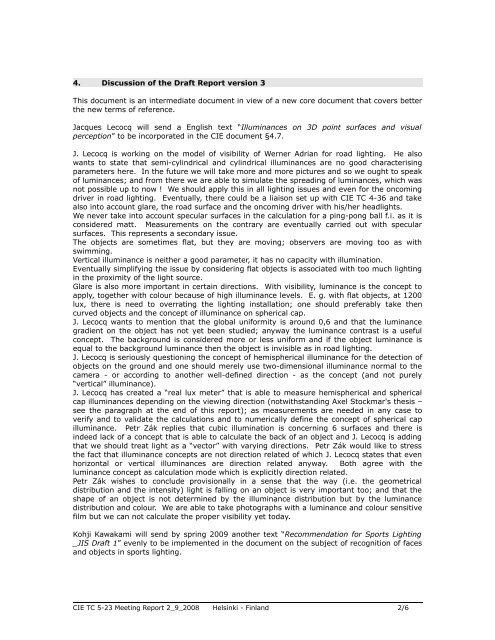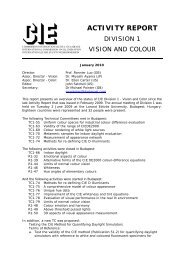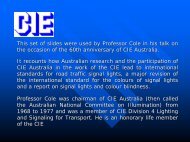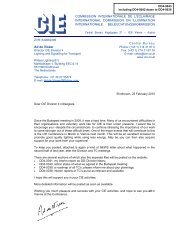commission internationale de l'eclairage international ... - CIE Australia
commission internationale de l'eclairage international ... - CIE Australia
commission internationale de l'eclairage international ... - CIE Australia
Create successful ePaper yourself
Turn your PDF publications into a flip-book with our unique Google optimized e-Paper software.
4. Discussion of the Draft Report version 3<br />
This document is an intermediate document in view of a new core document that covers better<br />
the new terms of reference.<br />
Jacques Lecocq will send a English text “Illuminances on 3D point surfaces and visual<br />
perception” to be incorporated in the <strong>CIE</strong> document §4.7.<br />
J. Lecocq is working on the mo<strong>de</strong>l of visibility of Werner Adrian for road lighting. He also<br />
wants to state that semi-cylindrical and cylindrical illuminances are no good characterising<br />
parameters here. In the future we will take more and more pictures and so we ought to speak<br />
of luminances; and from there we are able to simulate the spreading of luminances, which was<br />
not possible up to now ! We should apply this in all lighting issues and even for the oncoming<br />
driver in road lighting. Eventually, there could be a liaison set up with <strong>CIE</strong> TC 4-36 and take<br />
also into account glare, the road surface and the oncoming driver with his/her headlights.<br />
We never take into account specular surfaces in the calculation for a ping-pong ball f.i. as it is<br />
consi<strong>de</strong>red matt. Measurements on the contrary are eventually carried out with specular<br />
surfaces. This represents a secondary issue.<br />
The objects are sometimes flat, but they are moving; observers are moving too as with<br />
swimming.<br />
Vertical illuminance is neither a good parameter, it has no capacity with illumination.<br />
Eventually simplifying the issue by consi<strong>de</strong>ring flat objects is associated with too much lighting<br />
in the proximity of the light source.<br />
Glare is also more important in certain directions. With visibility, luminance is the concept to<br />
apply, together with colour because of high illuminance levels. E. g. with flat objects, at 1200<br />
lux, there is need to overrating the lighting installation; one should preferably take then<br />
curved objects and the concept of illuminance on spherical cap.<br />
J. Lecocq wants to mention that the global uniformity is around 0,6 and that the luminance<br />
gradient on the object has not yet been studied; anyway the luminance contrast is a useful<br />
concept. The background is consi<strong>de</strong>red more or less uniform and if the object luminance is<br />
equal to the background luminance then the object is invisible as in road lighting.<br />
J. Lecocq is seriously questioning the concept of hemispherical illuminance for the <strong>de</strong>tection of<br />
objects on the ground and one should merely use two-dimensional illuminance normal to the<br />
camera - or according to another well-<strong>de</strong>fined direction - as the concept (and not purely<br />
“vertical” illuminance).<br />
J. Lecocq has created a “real lux meter” that is able to measure hemispherical and spherical<br />
cap illuminances <strong>de</strong>pending on the viewing direction (notwithstanding Axel Stockmar's thesis –<br />
see the paragraph at the end of this report); as measurements are nee<strong>de</strong>d in any case to<br />
verify and to validate the calculations and to numerically <strong>de</strong>fine the concept of spherical cap<br />
illuminance. Petr Zák replies that cubic illumination is concerning 6 surfaces and there is<br />
in<strong>de</strong>ed lack of a concept that is able to calculate the back of an object and J. Lecocq is adding<br />
that we should treat light as a “vector” with varying directions. Petr Zák would like to stress<br />
the fact that illuminance concepts are not direction related of which J. Lecocq states that even<br />
horizontal or vertical illuminances are direction related anyway. Both agree with the<br />
luminance concept as calculation mo<strong>de</strong> which is explicitly direction related.<br />
Petr Zák wishes to conclu<strong>de</strong> provisionally in a sense that the way (i.e. the geometrical<br />
distribution and the intensity) light is falling on an object is very important too; and that the<br />
shape of an object is not <strong>de</strong>termined by the illuminance distribution but by the luminance<br />
distribution and colour. We are able to take photographs with a luminance and colour sensitive<br />
film but we can not calculate the proper visibility yet today.<br />
Kohji Kawakami will send by spring 2009 another text “Recommendation for Sports Lighting<br />
_JIS Draft 1” evenly to be implemented in the document on the subject of recognition of faces<br />
and objects in sports lighting.<br />
<strong>CIE</strong> TC 5-23 Meeting Report 2_9_2008 Helsinki - Finland 2/6







